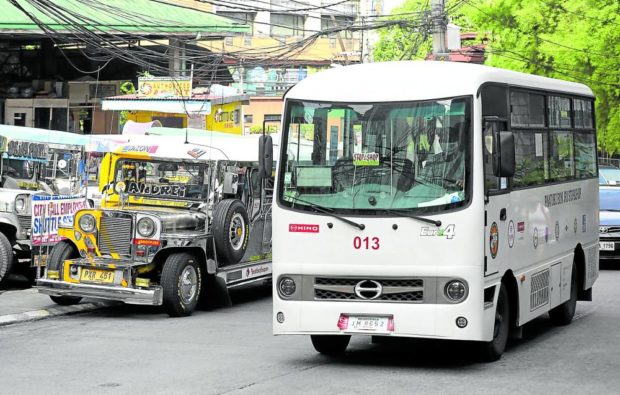
‘E’ FOR EXPENSIVE | Going green does not come cheap. Ask the operator of this “modern” jeepney photographed at Barangay Barangka Ilaya, Mandaluyong City, on June 26, 2020. (Photo by NIÑO JESUS ORBETA / Philippine Daily Inquirer)
MANILA, Philippines — A transport group is calling on the government to reevaluate the jeepney modernization program after experiencing problems in deploying electric jeepneys or e-jeepneys.
Ricardo Rebaňo, president of the Federation of Jeepney Operators and Drivers Association of the Philippines (Fejodap), said operators organized into a cooperative or corporation needed to pay a monthly amortization of P475,000 for the operation of 15 units of modern jeepneys.
“We have nearly negative earnings daily, sometimes just breaking even. How can we survive for seven years?” he told the Inquirer on Tuesday, referring to their payment period for e-jeepneys.
Host of expenses
The provisional authority or franchise for traditional jeepneys issued by the Land Transportation Franchising and Regulatory Board (LTFRB) is valid only until March 31 nationwide except for Metro Manila, where it will be valid until the end of April.
Rebaňo said they were not against the modernization program itself since it would benefit the entire country, especially the next generation.
But he asks: “How are we to benefit when those who have just entered the program are already having a hard time?”
Rebaňo estimated that the gross income e-jeepney operators get for a daylong operation amounted to P8,000. Around 50 to 55 percent of the amount goes to fuel alone and the rest would be allocated to other expenses, like amortization.
“That’s our situation, so we are left with nothing. We prioritize our (payment) obligations to show to the government that even though it’s really difficult for us, we’re finding ways to embrace the [modernization] program,” he said.
Fuel prices not helping
The Fejodap president lamented that even though drivers and operators had undergone seminars and training, they still found it difficult to manage their operations as a corporation or cooperative.
Under Order No. 2017-011 of the Department of Transportation, or the Omnibus Franchising Guidelines issued on June 19, 2017, only corporations or cooperatives with at least 15 vehicles would be allowed to apply for new routes, restricting jeepneys and other small-capacity vehicles on major roads.
“We tried to follow the government, the program, [but] this is what happened to us,” Rebaňo said.
“We are really struggling with the system that is going on. No matter what we do to manage, because of the constant increase in the price of petroleum products, we are suffering a lot,” he added.
For deadline extension
In a recent meeting with Transportation Secretary Jaime Bautista, Rebaňo said Fejodap had requested an extension of the March deadline for public transport franchise holders to consolidate into a single entity.
But according to LTFRB chief Teofilo Guadiz III, the board will stick to the original schedule and just help those who would not be able to comply to find secondary routes or alternative job programs.
“We should already push for modernized jeepneys. They are the ones losing now and if we won’t tighten [the restrictions], this program may not move forward at all,” Guadiz said in an dzBB interview.
“There are areas where modernized vehicles are enough. The traditional jeepneys will only run until March, then the modernized jeepneys will take over,” he said.
GenSan study
In a December 2021 study published in the Philippine Transportation Journal, researchers from the University of the Philippines Diliman took a closer look at the jeepney operations in General Santos City, one of the pilot cities for the program.
“Based on interviews and the operators’ survey, it was clear that modernization has been very costly, from the necessary capital investments down to the operational expenditures,” according to the study.
Titled “Examining the Implementation of the Public Utility Vehicle Modernization Program in General Santos City, Philippines: An Industry Perspective,” the study recommended that to ensure the continuation of the modernization program, it should go through proper legislation.
Local gov’t support
“Many players in the public transport sector like MGTC (Metro GenSan Transport Cooperative) have made large investments that losing the program may leave the industry in debt at the cost of thousands of livelihoods,” it said.
The researchers noted the city’s support and subsidy from the local government unit (LGU), saying the program could adopt practices that could be replicated by other LGUs so they could also finance the modernization of their public transport operators.
“The LTFRB should likewise have a better capacity to evaluate and adjust franchising requirements at [the] local level that is responsive to local context,” the study said.
According to the LTFRB, the program’s components include fleet modernization, route rationalization, LGU local public transport route planning, and industry consolidation that aims to establish transport cooperatives entitled to government subsidies and access to credit facilities.